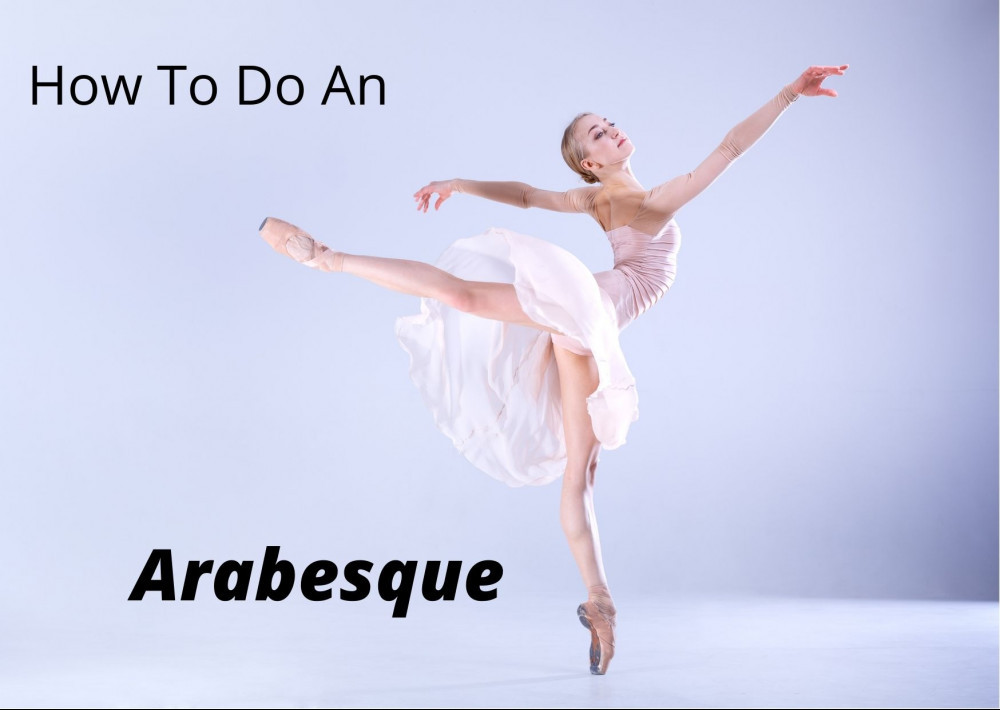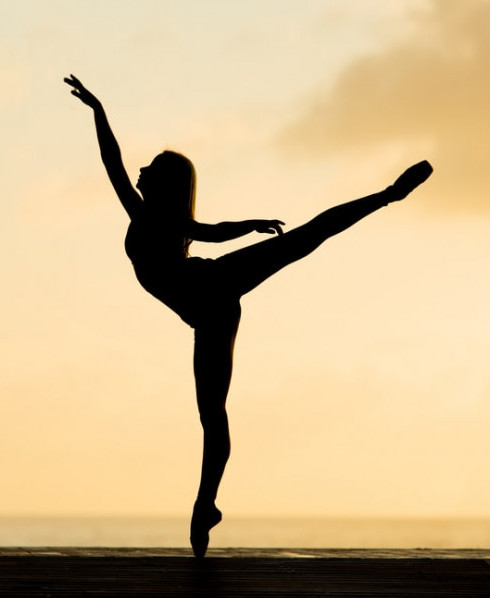If you look at general pictures of ballet dancers, you will invariably see a ballerina doing an arabesque. The arabesque is used a lot in ballet as well as in gymnastics and modern dancing.
The aim of the dancer is to produce a pretty line for his or her audience, and it takes years of practice to get it looking good.

What Is An Arabesque In Ballet?
An arabesque is a ballet dancing position in which the dancer is supported on one leg, either straight or, in some cases a demi-plié, while the other leg is extended straight behind. The shoulders are square and the arms are held in various positions to create a long line from fingertips to toes. An arabesque can be executed en pointe or on a flat foot.
Variations For The Arabesque
There are basically four different arabesque lines in ballet. They are all dependent on the arm placement, but the footwork is the same for all of them.
The leg is always behind the body, either on the floor or raised but it is extended. The dancer could either be en pointe as you see above or standing flat.
First
The same arm as the supporting leg is extended forward in line with the shoulder and raised higher than the shoulder. The side arm is extended back diagonally and is lower than the other arm. Both palms normally face the floor and the arms are straightened but soft.
Second
The same arm as the working leg is forward and at shoulder height. The rest of the body is as above.
Third
Both arms are extended straight forward in front of the body and are 12 inches apart. One arm is higher than the other. In third arabesque, the arm of the standing leg is higher than the other arm. The arm of the working leg is squared with the shoulders and is slightly lower than that of the standing leg.
Fourth
This is exactly the same as third arabesque with both arms forward and one foot apart but the arm of the working leg is now higher than the arm of the supporting leg.
In this video, Megan Wooden demonstrates first arabesque.
How To Do An Arabesque
Successfully completing the perfect arabesque is dependent on body position and support. These tips below will give you the foundation to perform a traditional arabesque.
Before trying an arabesque or any pose for that matter it is a good idea to stretch and warm up your body. This will prevent a pulled muscle in your back, especially if you are new to dancing.
Begin with first position with the heels together and the toes turned outwards.
Relax your arms and shoulders.
Shift your weight onto your supporting leg and glide the working leg behind you. Point the toes as you position the leg and place the weight over the ball of the supporting leg.
Make sure your back leg or working leg is straight while your supporting leg stays planted on the ground. Make sure to hold your turnout.
Place your arms in the correct arabesque position aiming to keep your shoulders square with your hips and your rib cage. If you are battling to balance, place one arm on the barre.
Make sure both feet are turned out. Hold your core and upper body throughout. It is always a good idea to get the correct line with the back leg still pointed on the floor, and once you have your balance, you can then lift the leg.
Now lift your working leg behind you using your core and supporting leg muscles for balance. Your back and hips will tilt slightly forward here but make sure you keep your back well held so it doesn’t flop forwards.
Both legs must remain straight and the toes of the working leg are well pointed. Be careful not to sickle the back foot.
It is a good idea to do this on both legs and if you are standing at the barre, use the leg closest to the barre as the supporting leg.


Arabesque-the iconic eye-catching pose and just magnificent.
I remember Christi Yamaguchi’s performance in the winter Olympics! She wakes me up happily filling my mind with awe and happiness.
It is never easy to touch the perfection you want. It needs years of practice fine-tuning the body.
I love the spectacular outfits my child wore at the age of six in a ballerina dance she participated. I enjoyed sitting and watching the kids in their class after my stressful day of work. Many times I would come out stressless.
The steps that you have delineated are what one actually has to follow to get eventual perfection. It is a great exercise for me. Using barre is good and helpful as you move up in your journey.
How early should one start out to make it easier to get going?
The younger you start ballet the better, before the body sets and gets too stiff, but even adults can start ballet and enjoy it as well as gain flexibility and grace. It just takes a bit longer.
The Arabesque is beautiful and iconic in Ballet! Such a great informative article you have explaining what it is about and proper form on how to produce the Arabesque. This article intrigued me to check out other parts of your site and I was very happy I did as it gave added appreciation for Ballet and Dancers as a whole and I look forward to reading more thought provoking pieces you deliver to your site in the future!
Thanks Daniel, and glad you enjoyed your visit.
Ballet is one of my favourite entertainments. I have not at any stage been a ballerina. However, my eldest daughter enjoyed learning ballet from an early age into her teenage years.
I’m sure she would have gained great help from a website such as yours, even though she learned from professional ballet dancers.
Having online access to assist with understanding movements such as Arabesque would have been wonderful.
A most enjoyable article.
Thank you.
Valerie
Thank you for your comment Valerie.
Very well put together I actually learned a lot thank you. For the time you put in to put this together
Ballet’s stunning and well-known Arabesque! What a wonderful, in-depth post you have describing the Arabesque’s purpose and appropriate execution. It does look beautiful if well done, but can look terrible too if badly executed.
My sister is studying ballet, so I think this post will be very useful to her. I have seen her practice. I will definitely send this to her. Keep posting like this.